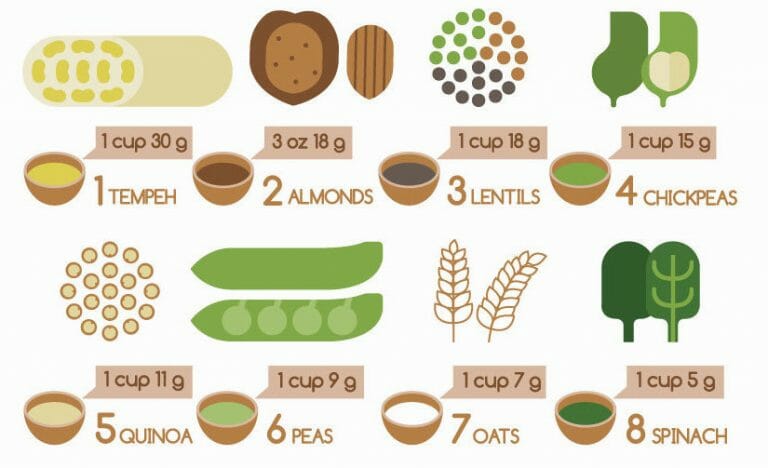You’re vegan, huh? No meat at all. Wow.
Interesting… so, how do you know if you get enough protein?
Here it is — the standard almost scripted inquiry that vegans likely encounter, day in and day out around water coolers across the country.
Non-vegans learn of their preferences on animal consumption and this tired but well-meaning interview process begins. Cue the eye-roll.
Typically, the question is followed up with a reasonable response in the form of an assurance such as Lots of beans. or Soy.
Seeds, nuts, quinoa, and a variety of protein powders such as hemp, rice, and pea, are all other ideal options which vegans reach for to supplement their protein intake.
Which certainly answers the question, “What do you eat for protein?”. However, it doesn’t answer the question, “How do you know if you are getting enough protein?”
Looking for an easy way to dial in your diet; click here to use the IIFYM macro calculator to find out your individual macros.
Crunching Numbers

There is only one way to know if you are getting enough protein (or carbs or fats, for that matter) and the answer is actually consistent for everyone, not just for vegans.
The only way to know if you are getting enough protein is:
1. To know how much you need.
and
2. To track it.
Let’s start with number two. Tracking is pretty easy to figure out.
Especially for those vegans who primarily get their protein source out of a package. Turn the package around, scan the nutritional data and voilà, the amount of protein per serving is right there in black and white.
Go low-tech and jot it down on a piece of paper or go high-tech and punch it into an app. Done.
But number one, on the other hand, could be a bit more of a complicated question to answer.
Remove the complication, let us help you build your Macro Blueprint.
The short answer is it depends on many factors.
The long answer is:
It depends on…
– Gender
– Age
– Height and Weight
– Activity Level
– Whether you want to lose fat, build muscle, or maintain your current body makeup
– Age
– Height and Weight
– Activity Level
– Whether you want to lose fat, build muscle, or maintain your current body makeup
Figuring out the answer to ‘it depends on’ can have you arousing brain neurons that have been asleep since 11th-grade math class.
(“Anyone? Anyone? Bueller?”)
What’s more, the answers to these questions change over time as new circumstances arise.
This only further complicates an already complicated conundrum.
If right about now you’re wishing that someone has come up with a nifty calculator in the same vein as those mortgage-rate number cruncher things, you’re down to two wishes.
There is such a thing, and the best part is- it’s free.
As a bonus, you’ll find out your carb and fat requirements as well.
Which brings up another point.
Vegans tend to get too many carbs and too much fat to meet their optimal fuel requirements. This is where IIFYM coaches can step in and guide you through the process.
Zeroing in on the Basics
Ironically, when viewing things from a sheer macronutrient perspective, the vegan diet plan closely resembles the stats on the Standard American Diet program, (you know, pizza, burgers, nuggets, lattes, etc.), which accounts for far too much carb and fat intake and not nearly enough protein.
The quality of food may be on the opposite ends of the spectrum, but when comparing apples to apples, or in this case macronutrient to macronutrient, they are essentially the same.
So organic, non-GMO, animal cruelty-free, high-fiber, additive-free, chemical-free, all-natural, local, homegrown, leafy-green, fresh, high in micronutrients like vitamins and minerals, etc… these are all concepts which point to the utmost standards in the human consumption of food and which are typically valued by followers of the vegan diet lifestyle.
Which is a good thing…No, it’s a great thing.
However, all of these considerations more often than not, overlook the most fundamental consideration which our bodies require. They miss the mark in determining the correct amount of macronutrients (which refers to the basic nutrients: proteins, fats, and carbs) required for an individual person.
Each person needs a particular amount of these macronutrients in order to function pro
Vroom-Vroom

Consider this: a standard gas powered vehicle needs fuel to drive. While there are several different levels of quality of gasoline to choose from at the fill-up station, there is no getting around it, the device needs fuel.
And, it also needs oil.
And, it also needs oil.
And water.
Keep your body fueled properly while dieting, let us put together your Macro Blueprint.
It may not need as much oil or water as it does, compared to fuel, but it just won’t function without all three being available.
Further, let’s say the fuel, oil and water are provided, just in the wrong amounts. Well, it may certainly roll on down the road, but it isn’t functioning properly and certainly not optimally. The damage is likely being done to the vehicle.
Same with us. We need all three macros in certain amounts.
Vegans Diet Plan and IIFYM
The vegan diet plan and If It Fits Your Macros [IIFYM] not only complement each other, it is actually critical for vegans to work IIF YM into their routine if they are looking to achieve peak performance.
“Am I going to have to track stuff?”, you ask.
Well, yes.</p
There is some effort involved. You’ll have to pay attention and be aware.
But for vegans, this should really be a non-issue. As a rule, vegans tend to have the admirable quality of going through life with their eyes open.
Here are some points to consider:
-Each person has a specific target of macronutrients (protein, carbs, and fats) to meet in order to achieve optimal health. [1]
-IIFYM provides an easy-to-use and free tool in the form of a calculator which determines individual macronutrient needs (based on age, gender, height, weight, activity levels and physical goals)
Many vegans are challenged with the prospect of sufficient protein supplementation in their regular diets. Many vegans account for an overabundance of fats and carbs in their regular diet plan.
Combining the vegan lifestyle together with the IIFYM tracking method serves as a convenient solution for vegans to meet the challenge of fulfilling their daily macronutrient needs.
Are you ready to get started?
Click here to use the IIFYM calculator and to find out your individual macronutrient requirements.
Bonus Tracks
Enjoy the following recipes that were developed for vegans who are looking to increase their protein consumption on a regular basis.
They are lightening quick to put together and were designed to be made in bulk and stored in the fridge or freezer in order to be on hand for quick access to fully prepared nutritionally correct nourishment. They were also created with versatility, frugality, and portability in mind.On-the-go fit foodies, rejoice.
They are lightening quick to put together and were designed to be made in bulk and stored in the fridge or freezer in order to be on hand for quick access to fully prepared nutritionally correct nourishment. They were also created with versatility, frugality, and portability in mind.On-the-go fit foodies, rejoice.
No comments:
Post a Comment